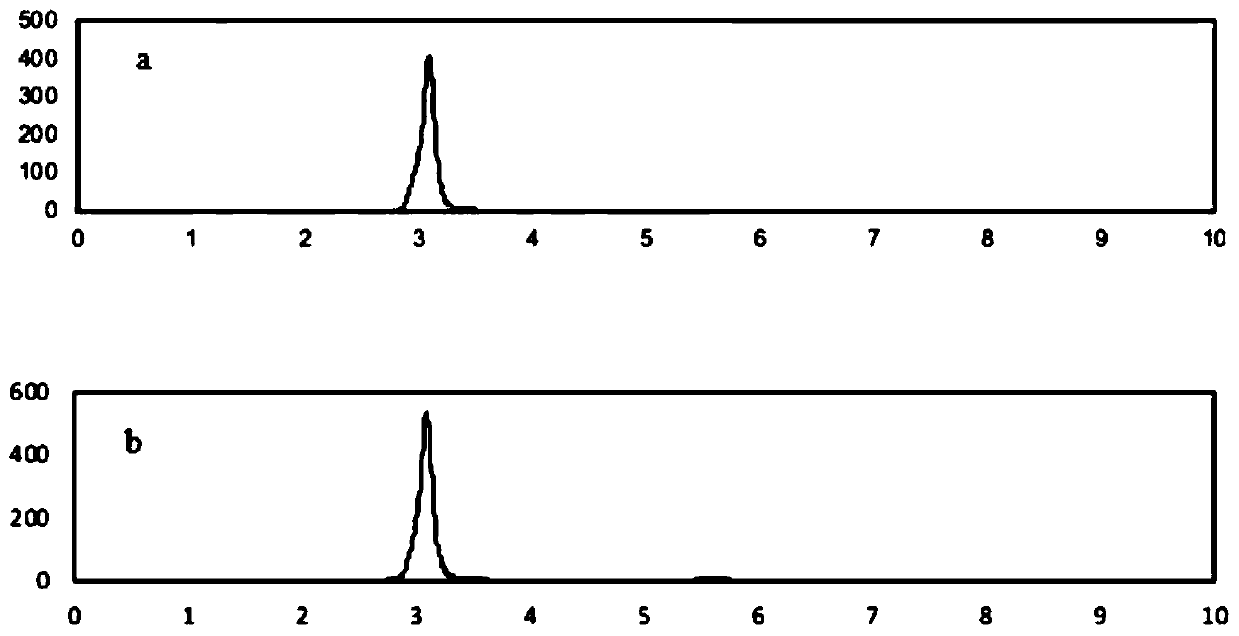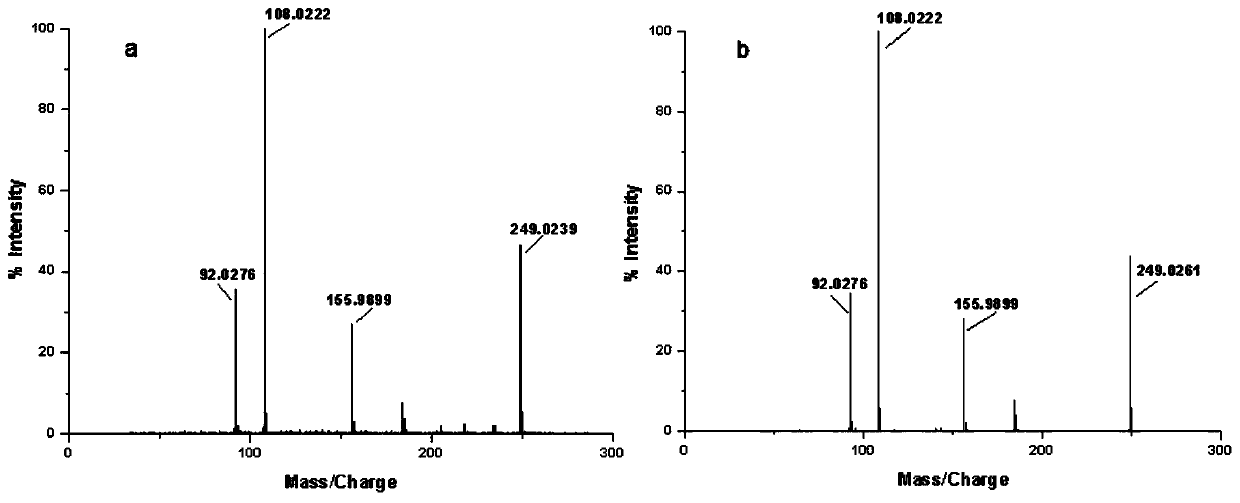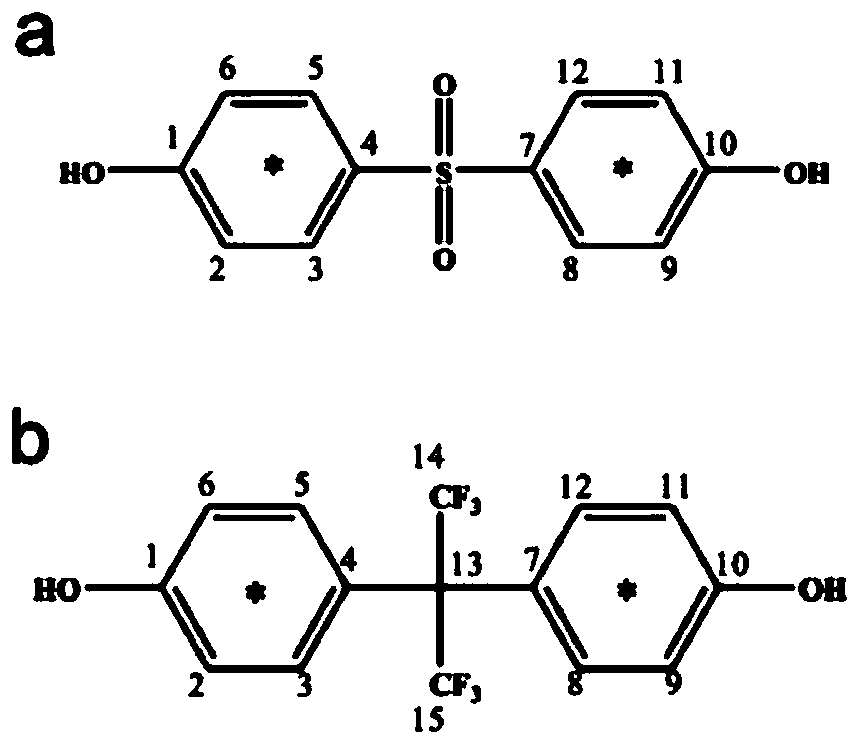Method for preparing carbon isotope markers bisphenol S and bisphenol AF
A carbon isotope and double-labeled technology, which is applied in the field of synthesis of carbon isotope-labeled compounds, can solve the problems of low yield of bisphenol AF, achieve the effect of simple preparation process, simple synthesis steps, and avoid complicated purification steps
- Summary
- Abstract
- Description
- Claims
- Application Information
AI Technical Summary
Problems solved by technology
Method used
Image
Examples
preparation example Construction
[0030] The invention provides a method for preparing carbon isotope-labeled bisphenol S, the carbon isotope-labeled bisphenol S includes 13 C labeled bisphenol S or 14 C labeling bisphenol S, including the following steps:
[0031] Mix carbon isotope-labeled phenol with sulfuric acid, carry out sulfonation reaction and condensation sulfone reaction in sequence in a protective atmosphere, and then use normal phase preparative liquid chromatography or normal phase preparative thin layer chromatography to separate and purify the obtained condensation sulfone product system, Obtain carbon isotope label bisphenol S; Described carbon isotope label phenol comprises 13 C labeled phenol or 14 C labeled phenol.
[0032] In the preparation method of carbon isotope labeling bisphenol S provided by the invention, when using 13 When C-labeled phenol is used as raw material, the prepared product is 13 C labeled bisphenol S; when 14 When C-labeled phenol is used as raw material, the pre...
Embodiment 1
[0064] First, non-labeled bisphenol S was prepared to determine the reaction conditions, and the structure of the synthesized non-labeled bisphenol S was characterized by electrospray mass spectrometry and nuclear magnetic resonance to confirm the structure.
[0065] Synthesis of unlabeled bisphenol S:
[0066] Weigh 100mg of phenol into a 10mL eggplant-shaped bottle, add 30μL of 98wt% concentrated sulfuric acid dropwise, under nitrogen protection, react at 125°C for 2.5h, then raise the temperature to 175°C for 3h; after the reaction, add 1mL of methanol The reaction product was dissolved, and the resulting mixed solution was concentrated under reduced pressure and then separated and purified by normal phase preparative liquid chromatography. The elution reagent was petroleum ether and ethyl acetate, and the flow rate was 5mL / min. Gradient elution, in terms of volume ratio, washing The initial composition of the elution reagent is petroleum ether: ethyl acetate = 4: 1; when t...
Embodiment 2
[0075] synthesis 14 C-bisphenol S ([U-ring- 14 C12]-BPS):
[0076] Add 3.1×107 Q 14 C-phenol (11mg; 2.4×10 8 Bq / mmol, dissolved in 200 μL of petroleum ether), and then dropwise added 3.3 μL of 98wt% concentrated sulfuric acid, under nitrogen protection, reacted at 125 ° C for 2.5 h, then raised the temperature to 175 ° C for 3 h; after the reaction, Add 1mL of methanol to dissolve the reaction product, concentrate the resulting mixture under reduced pressure, and then use normal phase preparative thin-layer chromatography to separate and purify. The size of the silica gel preparation plate is 20cm×20cm×2mm, and the developing solvent is petroleum ether and ethyl acetate (petroleum ether The volume ratio to ethyl acetate is 1:1), the separated silica gel powder is extracted 5 times with ethyl acetate, and the extract is concentrated under reduced pressure to remove ethyl acetate, then analyzed by liquid chromatography-radioactive detector coupling system ( Analytical condit...
PUM
 Login to View More
Login to View More Abstract
Description
Claims
Application Information
 Login to View More
Login to View More - R&D
- Intellectual Property
- Life Sciences
- Materials
- Tech Scout
- Unparalleled Data Quality
- Higher Quality Content
- 60% Fewer Hallucinations
Browse by: Latest US Patents, China's latest patents, Technical Efficacy Thesaurus, Application Domain, Technology Topic, Popular Technical Reports.
© 2025 PatSnap. All rights reserved.Legal|Privacy policy|Modern Slavery Act Transparency Statement|Sitemap|About US| Contact US: help@patsnap.com



